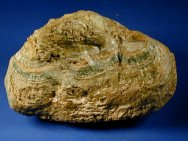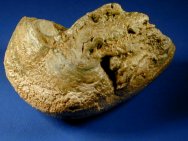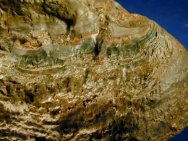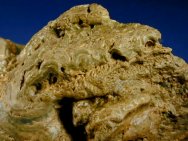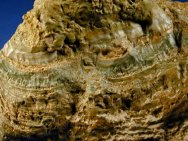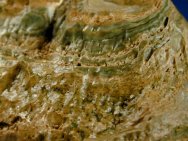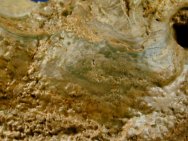|
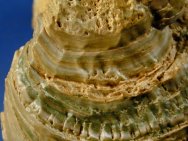 This
stromatolite in natural un-cut form is unique from several perspectives:
color, age and its naturally polished state. The distinctive green
coloration is most unusual that may represent a high copper content.
Interesting, due to exposure of the outcrop, the specimen has
been polished by wind and sand - in essence, sandblasted by nature
to have a smoothened surface. Finally, it is indeed, very young
for stromatolites, coming from the Middle Eocene of the Green
River Formation in Wyoming, a time when stromatolitic formations
on earth were on the defensive and ubiquitously replaced by modern
reef systems. This
stromatolite in natural un-cut form is unique from several perspectives:
color, age and its naturally polished state. The distinctive green
coloration is most unusual that may represent a high copper content.
Interesting, due to exposure of the outcrop, the specimen has
been polished by wind and sand - in essence, sandblasted by nature
to have a smoothened surface. Finally, it is indeed, very young
for stromatolites, coming from the Middle Eocene of the Green
River Formation in Wyoming, a time when stromatolitic formations
on earth were on the defensive and ubiquitously replaced by modern
reef systems.
By
the Eocene, stromatolites had markedly declined on earth, and
their formation was no longer predominately of prokaryotic origin,
as eukaryotic life such as plant-like algae was abundant and diverse
in marine and aquatic environments. This particular formation,
as indicated by the name Chlorellopsis, is presumed to be at least
in part of algal biological origin. But, it is reasonable to conjecture
that multiple and competing microorganisms, both prokarytic and
eukaryotic could probably contributed to the formation of these
unique and very pretty stromatolites.
Cyanobacteria that were responsible for Precambrian
stromatolites were once grouped with photosynthetic Algae, and
such grouping is still very prevalent in printed and Internet
literature (e.g., such terminology as algal mats). They are excluded
in modern molecular biology owing to large differences such as
the lack of organelles bound by a membrane, the bacterial, single
circular chromosome, and ribosomes having different size and content
from those of Eukaryotes. Algae are Eukaryotes and conduct photosynthesis
within membrane-bound organelles called chloroplasts. Chloroplasts
contain circular DNA and are similar in structure to Cyanobacteria,
presumably representing reduced cyanobacterial endosymbionts.
The exact nature of the chloroplasts is different among the different
lines of Algae possibly due to different endosymbiotic events
in deep time on Earth.
|

